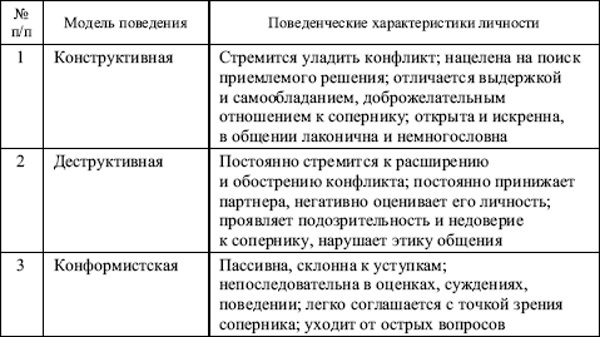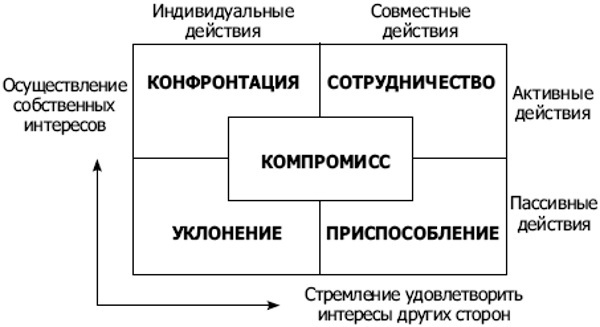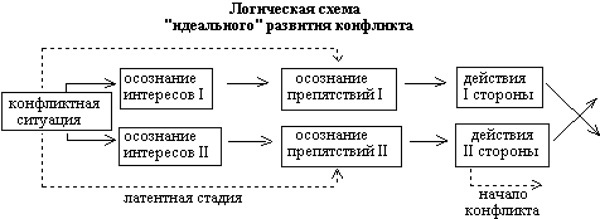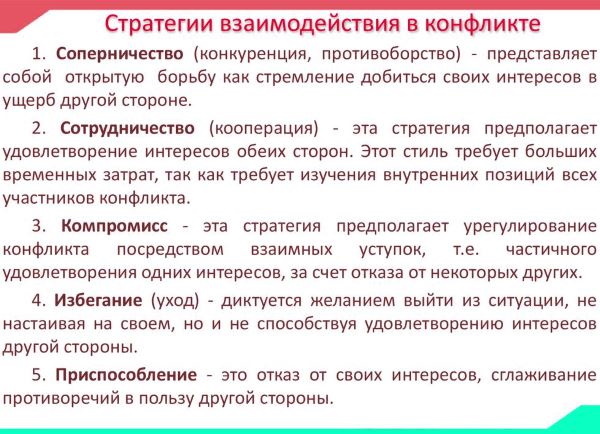Content
- Definition
- Classification
- Destructive and constructive
- Soft and hard
- In family relationships
- Confrontation based on nationality and religion
- When and why arises
- Stages of development
- Latent stage
- Confrontation
- Solution of a problem
- Post-conflict stage
- Management methods
- Negotiation
- Avoiding conflict
- Concessions
- Confrontation video
Confrontation in the conventional sense is confrontation, clash of different opinions. But this concept is also used as one of the psychological techniques that brings work with a client to another level.
Definition
Confrontation is used in psychology in psychotherapy when there is a conflict between the patient's conscious and unconscious desire to solve his problem and the desire to leave him. According to H. Garner, this technique involves the intervention of a specialist in the patient's narrative. Directive appeal to him is always accompanied by the question "What do you think?", "What do you feel?"
Further, the patient's responses can be divided into 3 categories:
- Agreement.
- Partial consent.
- Complete denial.
The doctor's provocative questions should push the patient to reassess behavior and judgments, help to develop a mutually satisfying way to solve the problem.
This technique is used in 3 cases:
- There are contradictions in human behavior.
- There are contradictions in beliefs.
- The patient deviates from the topic.
Confrontation takes up most of the life of people in general, not only in sessions with a psychologist and psychotherapist. Confrontation, difference of opinion takes place in any human sphere of activity. Therefore, the concept is divided into classifications.
Classification
Having considered the classification into which confrontation is divided, it is easier to understand the meaning of the term used in psychology. In simple colloquial speech, the word “conflict” is used instead of the word “confrontation”. This makes it easier to perceive the concept.
Destructive and constructive
In modern life, it is customary to divide confrontation into destructive and constructive. The first type leads to a solution to the problem that has arisen and is a lever that starts the process of transition to a general way out of the situation. At the same time, the solution to the problem suits both parties. From the outset, constructive confrontation between two or more parties does not look aggressive.
There are the following signs of a working confrontation:
- There is no aggression, mutual hostility.
- An adequate way to “let off steam” appears, to let go of negative emotions that have appeared due to disagreements.
- Shows hidden problems, helps to solve them.
- Each of the participants openly speaks their opinion regarding the question that has arisen.
Signs of destructive confrontation:
- Forms a negative climate between participants.
- Doesn't solve the problem.
- Aggression and mutual enmity appear.
- The participants in the conflict are divided into two camps, they are not interested in finding a common solution, each "pulls the blanket" to his side.
Soft and hard
Confrontation is the concept of opposition in psychology. The behavior of one of the parties to the conflict, trying to translate it into a more positive form, can be attributed to soft confrontation. Soft confrontation is not only present in a constructive way. Often a participant turns into a milder form when confronting a person who, in his opinion, finds him higher in status and age. Confrontation is not always appropriate.
A tougher confrontation is appropriate with loved ones, such as family and friends. In official conditions, tough behavior in a conflict may not be correctly assessed. For example, the situation with the boss at work. When a leader enters the stage of severe confrontation, it would be more correct to transfer him to a softer form, without substituting his professional position. At the same time, the employee does not keep silent, does not allow violating personal boundaries. Confrontation is opposition in psychology.
If it is impossible at the same level for the parties, then one of them may adhere to a soft position:
- Drawing attention to your side. An aggressive participant in the conflict often does not hear the opinion of the opponent.
- Request to stop conflicting behavior.
- Protest against the continuation of the conflict.
- Pause. Waiting for a reaction from a tough opponent.
- Thanks for a reasonable decision. Perhaps an apology for any actions if they crossed personal boundaries.
Arkady Egides is a Russian psychologist and doctor of psychological sciences.
He describes soft confrontation behavior a little differently:
- Description of your state to your opponent. It will help convey your feelings, intentions and thoughts to him.
- Request to remove the conflict generator. The concept includes signs, actions, words that generate conflict, feed it. This can include a rude tone, excessive gesticulation, the transition to insults.
- Partial excuse for a partner. This behavior shows that the participant understands his opponent.
- Suppression of their conflictogens.
- Submission of synthons. The term was introduced by A. Egides. It means an element of communication. This includes all actions that please the opponent.
In family relationships
In family relationships, confrontation is common.
This classification is divided into 3 more types:
- Classic. A common type of conflict is when family members argue over differences of opinion. And then they just put up. This type of confrontation does not harm family relationships if it does not go on a regular basis. In a positive way, classical confrontation in the family leads to mutual understanding, which is beneficial for all parties to resolve issues.
- Unresolved. This type includes all conflicts that have not been resolved. For example, there was a problem in the family. There was a conflict. It was not decided, one or all of the participants pretended that this is a passed stage. But there was no open dialogue, the expression of opinions, a profitable way out for all. Therefore, the question "smolders" in family relationships. Situations can accumulate, ultimately they provoke a large destructive conflict due to the fact that negative emotions have been kept for a long time. Such situations can destroy family ties.
- Crisis. Such confrontation occurs during difficult periods for families, characterized by a particular intensity of tension. If family members do not prioritize the preservation of relations, then confrontation turns into a destructive type. Such families break up, but there are situations when people live further together.
Confrontation based on nationality and religion
Confrontation on this basis is one of the most severe situations in the whole world. In the history of mankind, bloody, terrible events have been recorded against the background of such a confrontation.
What are the reasons:
- Racial affiliation.
- Ethnic language.
- Religion.
Usually, a conflict is provoked by a party that is considered relatively stronger and larger in number. Such confrontation is unhealthy and interferes with the normal development of society. The disagreement of the pressured side with the orders established by the strong side causes a strong stream of aggression. The conflict includes massive persecution, persecution, and violent measures.
The main solution that will eradicate confrontation over ethnicity and religion is the establishment of equal rights. An example from the history of mankind can lead to a conflict on the basis of different skin colors. Racial discrimination began as early as the 19th century. To date, the problem has been partially solved, thanks to the legislative initiative, social movements, and the creation of new thinking. But the struggle for equal rights continues to this day.
When and why arises
From the classifications of confrontation, one can also single out the reasons why they arise.
4 groups of reasons for confrontation:
- Socio-psychological.
- Personal.
- Organizational and managerial.
- Actually objective.
The last 2 groups are objective. The reasons for their occurrence include the conditions in which individuals interact. The environment creates a difference of opinion, a divergence of beliefs.
Subjective reasons for confrontation have a connection with the personal characteristics of the parties to the conflict. There are no definite reasons for the confrontation, as each situation is unique.
But the most common causes of conflicts can be identified:
- Natural divergence of opinions regarding different situations, due to the fact that everyone perceives it through the prism of their psyche.
- Divergence of spiritual values, material aspirations.
- Opponents' lifestyle.
- Stereotypes that formed many years ago about interactions between people.
- Low level of emotional intelligence.
- An unprepared legal framework that would allow regulating human relationships.
Stages of development
The development of confrontation is divided into stages, which have their own characteristic features. If you study the stages of development of confrontations, which are accompanied by differences of opinion, then you can easily find solutions in such situations. These stages of development of the situation are supported by the participants themselves, and unconsciously. The emotional attacks of the parties to the conflict depend on their preparedness.
Latent stage
Confrontation means opposition in psychology. The emerging disagreements between the participants indicate the pre-conflict stage.
There are some factors that may indicate the creation of a confrontation:
- There is a misunderstanding between interlocutors, partners, opponents. The process of transferring information is violated, the distortion of facts is possible.
- The environment leads to contradictions. For example, an authoritarian leadership style in organizations with pressure on the employee creates a negative environment. The lack of an opportunity for open dialogue and constructive confrontation causes dissatisfaction.
- Character traits, differences in spiritual values among different people. A conflict arises between people who perceive the surrounding world and situations in it differently.

These factors alone are not a cause of confrontation. But they set the stage for increased tension between the participants. When it occurs, the two sides easily move into the next stage of the development of confrontation. At another stage, it is more difficult to get out of the discussion.
Confrontation
When both sides want to prove their case, the conflict itself arises. This stage is characterized by an increase in tension, active manifestation of emotions.
Disagreements are obvious not only for the participants in the confrontation, but also for the witnesses of the situation, if any.
Here confrontation is divided into 2 types, which were described above. Destructive confrontation implies an active flow of negative emotions, trying to limit the actions of the opposite side. Destructive conflict can include insults, humiliation and even violence.
Constructive conflict implies an active dialogue between participants, where everyone can express their opinion. Both sides are interested in resolving the differences that have arisen. An active manifestation of emotions also takes place in this situation, but it is not negative.
At this stage of the development of confrontation, each participant needs to realize the essence of the problem that has arisen. To begin a settlement, each opponent must clearly state their position.
Solution of a problem
The parties should focus their efforts on solving the problem.
The methods for resolving situations are:
- Compromises.
- Cooperation.
- Violence.
- Avoidance.
The first 2 are healthy ways to deal with conflict situations. When solving a problem, the parties take into account the desires of each other, trying to get benefits for everyone. Cooperation can mean that one of the parties will be in a less advantageous position, but in return for any actions of the opponent.
The last 2 ways are toxic. Avoiding conflict does not solve the problem; it may “emerge” at the most inopportune moment for the participants later. One or all of the participants in the confrontation accumulate negative emotions, which in the future can turn into aggression.
Violence is always toxic behavior. This includes manipulation, ignorance - all these are methods of psychological violence. Physical violence implies that the abuser in a given situation is not able to resolve conflict situations, going beyond the framework. In this case, there should be no question of solving problems. The main task of a person to whom physical violence was manifested is to break off all contacts with the aggressor.
The ability to conduct a civilized open dialogue is the key to a successful solution to confrontation. The behavior of people in situations will help fix the problem without going through all the steps.
Post-conflict stage
The confrontation ends. The parties are summing up the results. Each of the participants determines for himself whether the expectations are justified. If the two parties were able to agree and calmly get out of the conflict, then such situations do not harm their relationship. If one of the parties remains in the red, then it retains a negative aftertaste, emotions continue to accumulate. Such an outcome could be the beginning of a new conflict on the same basis. Information exchange will be disrupted, possibly, the relationship will be completed between the parties.
If you learn to distinguish the stages of development of confrontation, then you can consciously approach the solution of the confrontations that have arisen between the parties. Participants will be able to rely not on emotions, but on common sense, which will help maintain relationships and find solutions to problems that will suit everyone.
Management methods
A healthy way out of confrontation is the desire of the participants to find a common solution to the problem. They are ready to hear the opposite point of view, perhaps to accept it.
 In addition to adequate methods of dealing with confrontation, there are negative methods that people unknowingly use.
In addition to adequate methods of dealing with confrontation, there are negative methods that people unknowingly use.
Negotiation
Confrontation is a difference of opinion in psychology. Negotiations are a tactical technique that will help find mutually acceptable ways out of the current situation.
For this method to work, certain conditions must be met:
- The parties to the confrontation are interdependent.
- There is no significant counterbalance between the powers, the forces of the parties.
- The stage of development of confrontation should correspond to the possibility of negotiations. At the latent stage, it is easiest to move on to negotiations. If there was violence at the stage of solving the problem, then the probability of negotiations approaches 0. In a constructive conflict, it is necessary to start negotiations after the emotions are thrown out.
Avoiding conflict
This method belongs to the reactive-aggressive methods of confrontation management.
But this method can be used in some situations:
- The topic of confrontation is banal and does not require a solution.
- There is a feeling that emotions are too tense and a “sobering up” of feelings is required.
- Bad time for discussion.
In other cases, avoiding conflict occurs with fear of the opponent. It is important to understand that avoiding confrontation does not always put an end to the issue that has arisen. The stressful situation often returns after a while.
Concessions
This method is used if one of the parties during the discussion discovers that she is wrong. Also, the method is used if the side agrees that the subject of the collision is more important for the opponent. Or there is a need to reduce losses.
In this case, one of the parties remains in the minority on its own initiative.

The general algorithm for influencing such situations is as follows:
- The parties acknowledge that there is disagreement.
- The possibility of negotiations is determined.
- The parties identify issues that have arisen in the process. An active discussion takes place.
- Creation of solution options.
- Decision-making.
- The confrontation is over. Admission in psychology is the healthiest one. This reduces the damage and preserves the relationship between the parties.
Confrontation video
Confrontation in psychotherapy:


